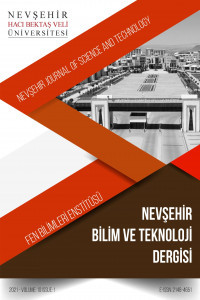Rize yöresi obsidyeninin çimentonun hidratasyon ısısına etkisi
Obsidyen., uçucu kül, yüksek fırın cürufu, hidratasyon ısısı
The effect of the obsidian of the rize region on the hydrating heat of cement
___
- [1] Erdoğan, S.T., Sağlık, A.Ü. 2013. “Early-age activation of cement pastes and mortars containing ground perlite as a pozzolan”, Cement & Concrete Composites, 38, 29–39.
- [2] Mielenz RC, Greene KT, Schieltz NC. Natural pozzolans for concrete. Econ Geol 1951;46:311–28.
- [3] Scholer, A., Lothenbach, B., Winnefeld, F., Zajac, M., 2015. “Hydration of quaternary Portland cement blends containing blast-furnace slag, siliceous fly ash and limestone powder”, Cement & Concrete Composites, 55, 374–382.
- [4] Uzal B., Turanlı, L., Yücel, H., Göncüoğlu, M.C., Çulfaz, A. 2010. “Pozzolanic activity of clinoptilolite: A comparative study with silica fume, fly ash and a non-zeolitic natural pozzolan”, Cement and Concrete Research, 40, 398–404.
- [5] Caputo, D., Liguori, B., Colella, C. 2008. “Some advances in understanding the pozzolanic activity of zeolites: the effect of zeolite structure”, Cement & Concrete Composites, 30, 455–462.[6] Marjanović, M., Komljenović, Z., Baščarević, V., Nikolić, R., Petrović, N. 2015. “Physical–mechanical and microstructural properties of alkali-activated fly ash–blast furnaceslag blends”, Ceramics International, 41, 1421–1435.
- [7] İlker Ustabaş, Effect of mineral additive use on permeation properties of concrete and the relationship between permeation and carbonation, (2018) Turkish Journal of Materials, Turk. J. Mater. Vol: 3 No: 1 Page: 38-52 [8] İlker Ustabaş, Şakir Erdoğdu, Performance of mortars incorporating fly ash, silica fume, blast furnace slag at different temperature in magnesium sulfate solution, (2016), Turkish Journal of Materials, Turk. J. Mater. Vol: 1 No: 1 Page: 1-14
- [9] Baran, T., Pichniarczyk, P. 2017. “Correlation factor between heat of hydration and compressive strength of common cement”, Construction and Building Materials, 150, 321–332.
- [10] TS 13515, TS EN 206’nın uygulamasına yönelik tamamlayıcı standard, Türk standardı, 2014.
- [11] Ilker Ustabas, Ayberk Kaya, Comparing the pozzolanic activity properties of obsidian to those of fly ash and blast furnace slag, Construction and Building Materials 164 (2018) 297–307.
- [12] Han, F., He, X., Zhang, Z., Liu, J., 2017. “Hydration heat of slag or fly ash in the composite binder at different temperatures”, Thermochimica Acta, 655, 202–210.
- [13] TS EN 197-1, 2012, Çimento
- ISSN: 2148-466X
- Yayın Aralığı: Yılda 2 Sayı
- Başlangıç: 2012
- Yayıncı: Nevşehir Hacı Bektaş Veli Üniversitesi
Slip Dökümle Üretilmiş Yunan Kırmızı Çamur Bünyelerin Sinterleme Özellikleri
Nermin DEMİRKOL, Vildan SAMANCI
Inverse Gas Chromatographic Determination of the Surface Properties of ZSM-5 Zeolite
Rize yöresi obsidyeninin çimentonun hidratasyon ısısına etkisi
Application of Fourier Transform Infrared (FTIR) Spectroscopy to Analysis of Clays
Ahmet YILDIZ, Bahri ERSOY, Haydar BAŞER, Can BAŞARAN, Metin BAĞCI
Saltuk Alper YAŞAR, Gültekin UZUN, İhsan KORKUT
Elektroeğirme Yöntemiyle Ag Katkılı Karbon Nanoliflerin Sentezi
Atilla EVCİN, Bahri ERSOY, Nalan ÇİÇEK BEZİR
Dursun ÖZYÜREK, İjlal ŞİMŞEK, Öznur DİNCEL, Doğan ŞİMŞEK
Alime ÇOLAK, Ferda MİNDİVAN, Meryem GÖKTAŞ
Farklı Presleme Basınçları İle Üretilen Toz Metal Çeliklerin Aşınma Davranışlarının Belirlenmesi
